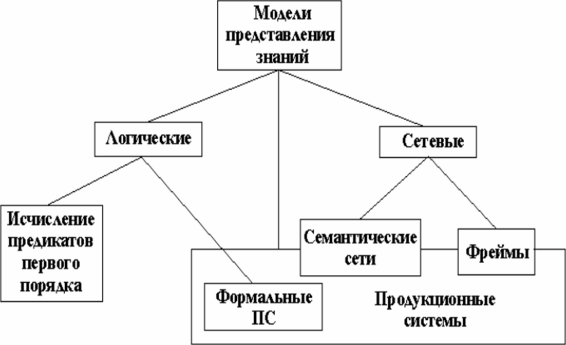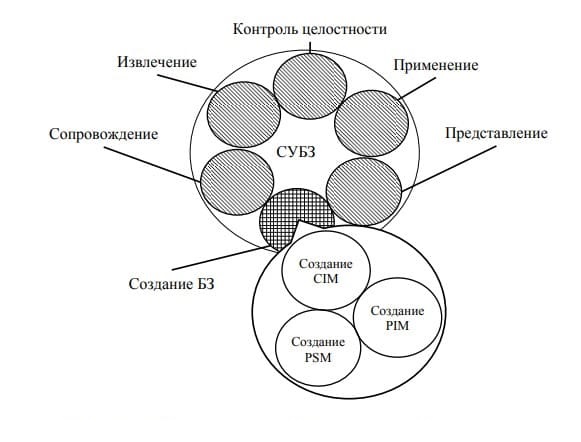Abstract
Contant author after that date to obtain complete text.
Content
1 Aims and tasks of the research
The aim of the research is to reduce the complexity of processing, reduce the search time and improve the quality of methodological material based on the reuse of accumulated knowledge and experience, designed according to special rules in the form of a computer knowledge base.
The tasks of the research:
- analysis of the state of modern research in the field of formation and support of knowledge bases
- overview of knowledge representation models;
- formulation of a mathematical model;
- developing your own knowledge base model
- software implementation of an intelligent system, verification of the effectiveness of the developed system
2 The review of the research and development
Researched theme is popular not only in international but also in the national scientific communities.
2.1 Overview of international sources
In the international space, in particular, in English sources, many books and works have been devoted to the principles and basic approaches to the formation of knowledge bases. Also, many works are devoted to the creation of intelligent systems that include these bases.
The Turkish Online Journal of Distance Education-TOJDE
[4] states that professional knowledge in educational institutions is not properly stored, it is also observed that information has been repeatedly generated, and knowledge at the institute remains unknown to gray literature, which may actually be helpful.
In the article Building a Knowledge Repository: Linking Jordanian
Universities Elibrary in an integrated database system
[5] Alhawary F.A. draws attention to the fact that the knowledge base in an educational institution will undoubtedly help in various report generation, strengthening graduate associations, improving student employment opportunities and new personnel in general (to improve the quality of work of staff and students, their productivity, reduce the time to solve problems associated with obtaining methodological information).
Interesting research into the application of knowledge management systems is presented in article Yaying Mary Chou Yeh The Implementation Of Knowledge Management System In Taiwan’s Higher Education
[6]. This information can be used for further scientific research, according to the author.
Another article by Towards Knowledge Handling in Ontology-Based Information Extraction Systems
[7]is devoted to the use of the right ontology-based information extraction system, since ontologies have proven to be effective and powerful tools for collecting and sharing knowledge, providing clear conceptualization specifications.
2.2 Overview of national sources
In national sources, the topic of creating intelligent systems with knowledge bases is as popular as in the international scientific community.
n the training manual nformation systems and knowledge bases
T.N. Lebedeva L.S. Nose, A.A. Ruzakova [8] presents the main provisions of the theory of information systems and knowledge bases from their occurrence to the modern presentation. Information, intellectual and corporate systems are considered, their definitions, classifications, architectures and stages of their development are given.
The project Methodology and Technology for the Formation of Ontologies based on Integration with Heterogeneous Data Sources (METEOR)
[9] is aimed at solving the urgent problem of designing and building knowledge bases of subject areas based on ontologies through the integration and processing of structured data arrays from heterogeneous sources. The project will fill the gap between the practical needs of enterprises and organizations and existing technologies and methods for working with ontologies.
Article M.A. Grishchenko РThe development of knowledge bases and expert systems based on a model-oriented approach
describes how, when describing a platform-independent model, to use, in addition to the UML, developed by the author, a notation for representing products called Rule Visual Modeling Language (RVML). To model the functionality, elements of ODA, Ontology Driven Architecture, an ontology-driven architecture, were used. [10].
Also, in the work of the Laboratory of Intelligent Systems ITMO How to create the right ontology. Part I.
[11] draws our attention to where it is worth starting the development of ontology.
2.3 Overview of local sources
Knowledge work, intellectual systems and ontology are devoted to some of the work of masters of DonNTU.
Student DonNTU, Bazhanova A.I. the scheme of the semantic information retrieval, the place of the ontological model in it is considered. The main tools for constructing ontologies are analyzed. A comparative analysis of the main models of data presentation in ontologies, as well as the main languages ??for describing ontologies and editors for working with them, in the article Research on the use of ontological models for semantic search
[12]
In the work of S.P. Nekrashevich Construction of an ontology model of an intellectual system for monitoring the educational process of distance education
[13] proposes a formal ontology model of an intellectual system for monitoring the educational process of distance education, which is the primary stage in the development of an intellectual system
Article [14] Bolotova V.A. It provides us with the conclusion that research aimed at developing such an approach to the representation and replication of knowledge is currently relevant that, on the one hand, would allow for the most adequate consideration of the specifics of the problem area, and on the other hand, present and use knowledge in some unified form.
In another work of a student of DonNTU, V.E. Niftaliev [15]
Creation of an ontological knowledge base of a recruiting system
methods for constructing ontologies are considered. The optimal method was selected that allows the best way to formulate, structure and present data and knowledge.
3 Knowledge Representation Models
As you know, knowledge in the knowledge base is presented in a certain form. The form of knowledge representation has a significant impact on the characteristics and properties of the system; therefore, the representation of knowledge is one of the most important problems characteristic of knowledge-based systems.
The problem of the representation of knowledge lies in the discrepancy between the information on the dependencies of a given subject area available to a specialist, the methods used to solve problems, and the possibilities of a formal (unambiguously limited) presentation of such information in a computer. Often the problem is complicated by difficulties for the expert in formulating explicitly his knowledge. A number of models are identified to solve the problem posed related to the formalization and presentation of knowledge in the memory of information systems[17].
3.1 Classification of knowledge representation models
Representation models of knowledge belong to the pragmatic direction (based on the assumption that the mental activity of a person is a “black box”) in research on artificial intelligence. Moreover, in knowledge-based systems, information structures are represented in the form of declarative (descriptive) knowledge, and algorithms and heuristics in the form of procedural knowledge.
Based on the review, the most commonly used and currently popular knowledge representation models were identified:

Consider these models in more detail. The main idea in constructing logical models of knowledge is that all the information necessary to solve applied problems is considered as a set of facts and statements that are presented as formulas in some logic. Knowledge is displayed by the totality of such formulas, and the acquisition of new knowledge is reduced to the implementation of inference procedures. The basis of logical models of knowledge is the concept of a formal theory defined by a tuple
When the frame is specified, specific names are assigned to it and the slots, and the slots are filled. Thus, instance frames are obtained from protoframes. The transition from the original protoframe to the instance frame can be multi-step, due to the gradual refinement of the values of the slots.
With a deep analysis of each of the presented models of knowledge representation, you can see the advantages and disadvantages of each of them.
The advantages of the logical model of knowledge representation are the uniqueness of the theoretical justification and the possibility of implementing a system of formally accurate definitions and conclusions. However, when solving complex problems, an attempt to present the expert’s informal knowledge, among which heuristics prevail, encounters serious obstacles in the system of strict logic. This is due to the fact that, in contrast to strict logic, the so-called “human logic” has a fuzzy structure. Therefore, most of the achievements in the field of systems with knowledge bases so far have been associated with the use of non-logical models.
As for network models, their main advantage is to a greater extent the conformity with other models to modern ideas about the organization of long-term memory of a person, and the disadvantage is the complexity of organizing the procedure for finding output on a semantic network.
The advantages of production models are the simplicity of creating and understanding individual rules, the simplicity of replenishment and modification, the simplicity of the inference mechanism; the disadvantages are the ambiguity of the mutual relations of the rules, the difficulty of evaluating a holistic image of knowledge, the extremely low processing efficiency, the difference from the human structure of knowledge, the lack of flexibility in the logical conclusion.
The main advantage of the frame model of knowledge representation is that it reflects the conceptual basis of the organization of human memory, as well as its flexibility and visibility. The language for representing knowledge based on the frame model is especially effective for the structural description of complex concepts and solving problems in which, in accordance with the situation, it is desirable to use various output methods. At the same time, such a language makes it difficult to manage the completeness and constancy of a holistic image. In particular, for this reason, there is a great danger of a violation of the attached procedure. It should be noted that a frame system without an attached procedure mechanism (and, consequently, a message forwarding mechanism) is often used as a database of a production system[17].
The advantages of mathematical models are that they are accurate, abstract, and transmit information in a logically unique way. The models are accurate because they allow us to make predictions that can be compared with real data by setting an experiment or making the necessary observations. The models are abstract, since the symbolic logic of mathematics extracts those and only those elements that are important for the deductive reasoning logic, excluding all extraneous values. The disadvantages of mathematical models are often the complexity of the mathematical apparatus. There are difficulties translating the results from the language of mathematics into the language of real life. Perhaps the biggest drawback of the mathematical model is related to the distortions that can be introduced into the problem itself by stubbornly defending a specific model, even if in reality it does not correspond to new facts[17].
3.2 Overview of Knowledge Base Design Approaches
Model Oriented Approach
According to one of the implementations of the model-oriented approach – Architecture controlled by a model or MDA [18], the process of developing an information system includes a description of the basic concepts of a subject area, the relationships between them and how they are processed and is presented in the form of a multitude of information models that determine the composition , structure and behavior of the future software product. At the same time, several models are distinguished: computationally independent - CIM (Computation Independent Model), platform-independent – PIM (Platform Independent Model), platform-dependent – PSM (Platform Specific Model) and platform models – PDM (Platform Description Model).
CIM and PIM do not contain binding to specific languages ??or implementation environments and are, in essence, domain models. PSM and PDM depend on the development platform and act as adapters or translators that convert domain models to program code or interpret them. At the same time, the process of developing information systems is a sequential transition from model to model, accompanied by their transformation or interpretation. The figure shows the scheme of the BMS, on which the function of creating knowledge bases is highlighted and decomposed [19].

An important aspect of the application of MDA is visual modeling. Moreover, MDA traditionally uses UML (Unified Modeling Language) to build domain models. UML does not allow for a clear and unambiguous presentation of cause and effect dependencies; therefore, when describing PIM, it is proposed to use, in addition to UML, the author's notation Rule Visual Modeling Language (RVML) to represent products. The proposed notation is more expressive in describing cause-effect dependencies compared to UML.
Conclusions
An ontological study of knowledge about the process of automated learning allows you to naturally take into account the essential properties and relationships of objects in a problem area. The advantage of a fuzzy model representation of the distinguished classes of ontology in the relational database of IP is the consideration of the linguistic uncertainty of expert knowledge. The software implementation of the proposed approach will allow differentiated, and therefore effective, to organize the process of automated learning, access to information and its structuring.
References
- 1. Информационные системы и базы знаний - Учебно-методическое пособие [Электронный ресурс]. Режим доступа: http://elib.cspu.ru/
- 2. Формирование базы знаний - Каминсофт [Электронный ресурс]. Режим доступа: http://www.kaminsoft.ru/
- 3. База знаний — для кого и для чего? - Журнал
ЭЛЕКТРОЭНЕРГИЯ. Передача и распределение
[Электронный ресурс]. Режим доступа: https://www.ruscable.ru/ - 4. Turkish Online Journal of Distance Education-TOJDE - [Электронный ресурс]. Режим доступа: https://files.eric.ed.gov/
- 5.Building a Knowledge Repository: Linking Jordanian Universities Elibrary in an integrated database system/Journals /International Journal of Business and Management [Электронный ресурс]. Режим доступа: http://www.ccsenet.org
- 6. The Implementation Of Knowledge Management System In Taiwan’s Higher Education(Yaying Mary Chou Yeh) [Электронный ресурс]. Режим доступа: https://pdfs.semanticscholar.org
- 7. Procedia Computer Science - Towards Knowledge Handling in Ontology-Based Information Extraction Systems [Электронный ресурс]. Режим доступа: https://www.sciencedirect.com/
- 8.Учебно-методическое пособие - базы знаний [Электронный ресурс]. Режим доступа: http://elib.cspu.ru/
- 9. Методология и Технология формирования Онтологий на основе интеграции с гетерогенными источниками данных (МЕТЕОР) [Электронный ресурс]. Режим доступа: https://gsom.spbu.ru/
- 10. М.А. Грищенко
Разработка баз знаний и экспертных систем на основе модельно-ориентированного подхода
[Электронный ресурс]. Режим доступа: https://docplayer.ru/ - 11. Лаборатория интеллектуальных систем ИТМО - Как создать правильную онтологию. Часть I. [Электронный ресурс]. Режим доступа: http://masters.donntu.ru/
- 12. Бажанова А.И.
Исследование применения онтологических моделей для семантического поиска
[Электронный ресурс]. Режим доступа: http://masters.donntu.ru/ - 13. С.П. Некрашевич
Построение модели онтологии интеллектуальной системы мониторинга учебного процесса дистанционного образования
[Электронный ресурс]. Режим доступа: http://masters.donntu.ru/ - 14. Болотовой В.А.
Инструментальные средства создания баз знаний на основе системы онтологий
[Электронный ресурс]. Режим доступа: http://masters.donntu.ru/ - 15. Нифталиев В.Э.
Создание онтологической базы знаний рекрутинговой системы
[Электронный ресурс]. Режим доступа: http://masters.donntu.ru/ - 16. Классификация моделей представления знаний - СтудРеф[Электронный ресурс]. Режим доступа: https://studref.com/429298
- 17. Современные модели представления знаний в обучающих системах - КиберЛенинка[Электронный ресурс]. Режим доступа: https://cyberleninka.ru/article/
- 18. Николайчук О.А., Павлов А.И., Юрин А.Ю. Компонентный подход: модуль продукционной экспертной системы // Программные продукты и системы. 2010. № 3. С. 41-44.
- 19. Разработка баз знаний и эспертных систем на основе модельно-ориентированного подхода[Электронный ресурс]. Режим доступа: https://docplayer.ru/

